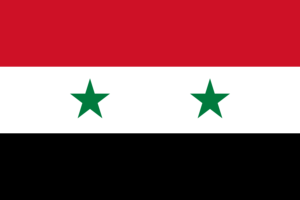History of Syria:
The Semitic Empire, one of the world’s earliest civilizations, was based in Syria. Much of the area between the Red Sea and Turkey was covered by it. Its largest city, Ebla, is thought to have had a population of 260,000.
Syria was conquered by various empires and civilizations, including the Canaanites, Phoenicians, Hebrews, Assyrians, Babylonians, Persians, Greeks, Romans, and Byzantines, due to its location between the Middle East and Europe. The Ottoman Empire eventually took control of the region. Syria has a significant role in Christian history. Paul established the first Christian church in the Syrian city of Antioch while traveling to Damascus.
Syria was under French rule after World War I, and France granted it independence in 1946. However, a string of military coups against the government caused discontent in the nation. While there is ongoing animosity with Israel over earlier battles and the Golan Heights, the region between the two countries, some stability has been achieved today.
Information about Syria:
| Capital | Damascus |
| Population | 23,433,994 (Source: 2023 worldometer) |
| Major Cities |
Damascus (capital), Aleppo, Deir ez-Zur, Hama, Homs, As Suwayda, Daraa, Ar Raqqah, Tartus
|
| Borders | Turkey to the north, Lebanon and Israel to the west and southwest, Iraq to the east, and Jordan to the south |
| Gross Domestic Product (GDP) | $65 billion (2019 worldometer) |
| Currency | Syrian pound (SYP) |
Flag of Syria:
Syria Economy Key Industries:
Syria Major Industries: petroleum, textiles, food processing, beverages, tobacco, phosphate rock mining
Syria Agricultural Products: wheat, barley, cotton, lentils, chickpeas, olives, sugar beets; beef, mutton, eggs, poultry, milk
Syria Natural Resources: petroleum, phosphates, chrome and manganese ores, asphalt, iron ore, rock salt, marble, gypsum, hydropower
Syria Major Exports: crude oil, petroleum products, fruits and vegetables, cotton fiber, clothing, meat and live animals, wheat
Syria Major Imports: machinery and transport equipment, electric power machinery, food and livestock, metal and metal products, chemicals and chemical products, plastics, yarn, paper
The Geography of Syria:
Total Size of Syria: 185,180 km2 (source: wikipedia)
Geographical Low Point of Syria: unnamed location near Lake Tiberias -200 m
Geographical High Point of Syria: Mount Hermon 2,814 m
Climate of Syria: mostly desert; hot, dry, sunny summers (June to August) and mild, rainy winters (December to February) along coast; cold weather with snow or sleet periodically in Damascus
General Terrain of Syria: primarily semiarid and desert plateau; narrow coastal plain; mountains in west
World Region or Continent of Syria: Middle East
Geographical Coordinates: 35 00 N, 38 00 E
The People of Syria & Culture
Syria Government Type: republic under an authoritarian, military-dominated regime
Syria Nationality: Syrian (s)
Syria National Holiday: Independence Day, 17 April (1946)
Syria Independence: 17 April 1946
Syria National Symbol: hawk
Syria National Anthem or Song: Humat ad-Diyar (Guardians of the Homeland)
Syria Languages Spoken: Arabic (official); Kurdish, Armenian, Aramaic, Circassian widely understood; French, English somewhat understood
Syria Religions: Sunni Muslim 74%, Alawite, Druze, and other Muslim sects 16%, Christian (various sects) 10%, Jewish (tiny communities in Damascus, Al Qamishli, and Aleppo)
Interesting Facts about Syria:
With a history spanning more than 4,000 years, Damascus is one of the oldest cities in the world to have been continually inhabited.
Six UNESCO World Heritage Sites, including the historic towns of Aleppo and Palmyra, are located in Syria.
The oldest continually inhabited capital in the world is thought to be Damascus, which is in Syria.
The three stars on Syria’s national flag stand for the ideologies of socialism, freedom, and unification.
The Syrian pound (SYP) is the official currency of Syria.
One of Syria’s greatest cities, Aleppo, served as a key crossroads on the Silk Road.
Syria’s varied topography includes deserts, mountains, plains along the coast, and fertile valleys.
Homs earned the moniker “City of Emperors” because of its historical significance during the Roman Empire.
The old, deserted settlements known as the “Dead Cities” in northern Syria offer a window into the past of the area.
The well-preserved Roman ruins of Palmyra, an ancient city that formerly served as a significant commerce hub, are well-known.
Numerous archaeological sites, including Roman theatre, temples, and tombs, can be found in Syria.
One of the biggest and oldest mosques in the world, Aleppo’s Great Mosque dates back to the eighth century.
Syria has a strong literary history and has given the world notable authors and poets like Nizar Qabbani and Adonis.
During the Bronze Age, the Syrian ancient city of Mari served as a key hub for trade and diplomacy.
Syria’s traditional music, which frequently uses instruments like the oud and ney, is renowned for its lyrical and rhythmic complexity.
There are many prominent Christian pilgrimage sites in Syria, and the nation is home to a sizeable Christian community.
One of Russia’s most important naval stations is located in Tartus, a city on the Mediterranean coast.
Syria’s economy is based on a number of industries, including agriculture, manufacturing, and oil extraction.
Kibbeh, a traditional Syrian meal made with bulgur and ground beef, is well-known in Middle Eastern cooking.
Arab, Kurdish, Turkmen, and other ethnic groups live in Syria, which has a diverse population.
Syria, which is in the Middle East, borders Turkey, Iraq, Jordan, Israel, and Lebanon on land.


